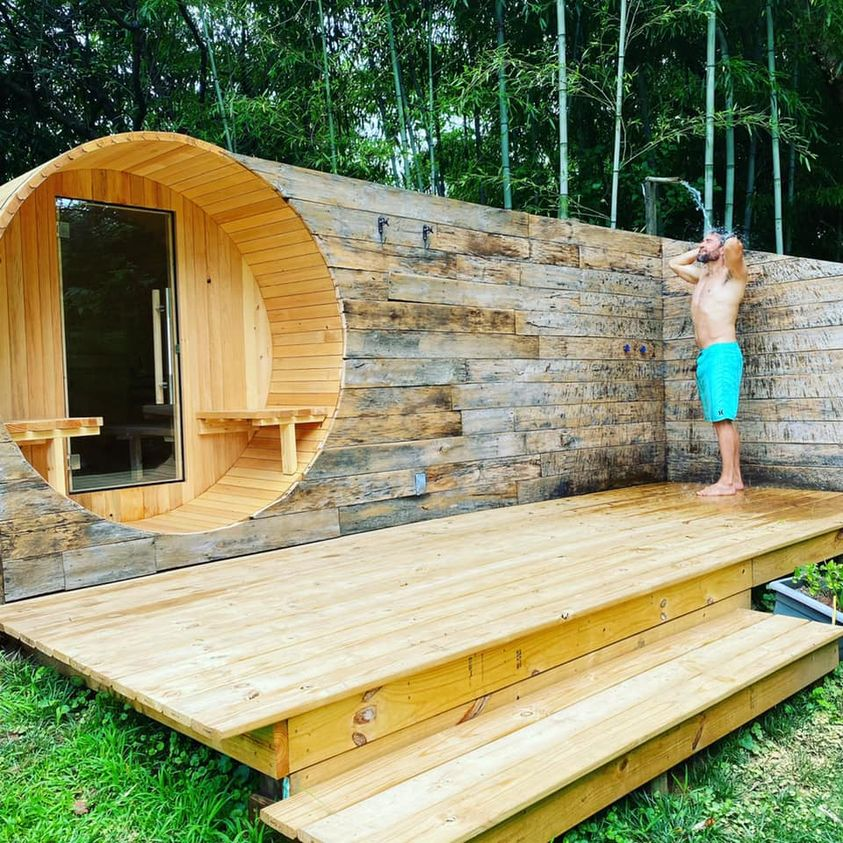Are you looking for a way to stay fit and relaxed? Installing an outdoor sauna at your home is the perfect solution!
You may be wondering how to set up such a sauna, but fear not – with our guide, it’ll be easy and effortless. Get ready to transform your backyard into your own personal paradise!
An outdoor sauna is an increasingly popular addition to many homes, allowing you to relax after a long day or simply enjoy some time in nature. While the concept itself is straightforward, turning your vision into reality can seem daunting if you don’t know where to start.
To make sure that setting up an outdoor sauna at your home goes as smoothly as possible, there are a few necessary steps that need to be taken.
This guide will provide all the information you need on a successful construction and installation of your own outdoor sauna. It will also discuss helpful tips and tricks on how to get the most out of your new sauna experience, ensure safety along the way, and create something that is truly unique and special.
Briefly explain the benefits of having an outdoor sauna at home
Having an outdoor sauna in your own backyard or patio can provide numerous physical and mental health benefits. It is a great way to relax after a long, stressful day and promote better sleep. An outdoor sauna session can also help improve circulation and reduce the risk of sports-related injuries.
It has been known to reduce inflammation, reduce muscle tension and pain, alleviate joint pain, as well as improve skin tone and clarity. In addition, it provides a great platform for socializing with family or friends, leading to increased feelings of wellbeing.
Mention that setting up an outdoor sauna is relatively simple and can be done by most homeowners
Setting up an outdoor sauna is relatively simple and can be done by most homeowners, even those with limited experience in construction. While there are DIY plans online to build a complete sauna from scratch, it’s more cost effective to purchase a pre-built sauna. There are many different types of outdoor saunas available, including cedar and insulated aluminum models that can be either freestanding or set up as an extension of your home. Before you buy, make sure you understand the exact measurements for the space where it will be located, as well as any local building codes that may apply.
Once you’ve chosen the type of sauna that’s best for your yard, you’ll want to determine the ideal location and assemble the frame of your sauna according to instructions and diagrams included with the purchase. If necessary, additional parts like insulation and vapor barriers should be installed at this point. After assembling and installing all components, you can add accessories such as benched seating and reading materials while also focusing on proper ventilation by correctly placing an exhaust fan or vent cap. Finishing touches such as lighting can also add ambience — small lanterns work especially well since they don’t need additional wiring setup or complicated installation instructions. With a few hours of work (and maybe some help from friends) you could have your dream outdoor sauna built in no time!

Selecting the Right Location
When considering your sauna setup, the location is key to success. The ideal place for an outdoor sauna should be in a fairly secluded spot, away from direct sunlight and wind exposure. You also want to evaluate the available space; a typical sauna will require at least 200 square feet of space. Make sure that any area you are considering is free of obstacles like trees or poles.
Before making your final selection, it’s important to check the local codes and regulations to make sure you stay in compliance with zoning laws. Additionally, take into account the terrain surrounding your chosen area; since this will be an outdoor structure, you may need to level out any uneven ground or consider installing steps for easy access. Moreover, if you plan on running a power line for lights or other components of an outdoor sauna, it may be helpful to hire an electrician who can determine how best to safely connect power in this environment.
Discuss the importance of selecting a suitable location for the outdoor sauna
When preparing to purchase and install an outdoor sauna, it is important to consider the location. While some people prefer to keep their sauna close to their home or in the backyard, others may opt for a more secluded spot. Regardless of your preference, proper planning is essential for achieving safe and comfortable conditions.
When selecting a location for your outdoor sauna, several considerations should be taken into account. First off, choose a spot that receives full sunlight during the day as this is crucial for boosting the sauna’s internal temperature. To prevent rusting of metal fixtures due to condensation, it’s important that you don’t place the sauna on damp grass or under trees. It’s also essential that the surrounding area is flat and level so that one can step safely into and out of the sauna without any difficulty. Lastly, make sure your outdoor unit has cabled electricity accessible so as to power its heating component and other accessories like lighting and sound systems — which can be great additions when hosting guests in your new outdoor sanctuary!
Factors to consider when choosing a location, such as proximity to the house, level ground, and privacy
Choosing an appropriate location for your outdoor sauna is essential to having a safe and relaxing experience. Before setting up your outdoor sauna, consider how close it will be to the house. Make sure to place the sauna far enough away that you don’t create a fire hazard.
You should also look for level ground in order to ensure that the sauna is stable and secure. Make sure that the ground is free of debris, such as sticks or leaves, so that you don’t trip while entering and exiting the structure.
Additionally, find a spot where there is adequate privacy. If possible, avoid putting your outdoor sauna close to neighbors’ houses or areas with a lot of foot traffic in order to ensure maximum comfort during use.
Once you have found a suitable spot for your sauna, you can begin building it!
III. Choosing the Type of Sauna
There are two main styles of outdoor saunas that you can choose from: traditional saunas or infrared saunas.
Traditional saunas heat the body with hot dry air. This type of sauna works by heating up rocks or metal in the center of the sauna and then using fans to circulate the hot air around. Traditional saunas tend to be more expensive than infrared, as they require more electricity and materials for insulation and construction, as well as running all-year round. The thermometer will typically run higher in a traditional outdoor sauna, at between 120-190 degrees Fahrenheit (50-85 degrees Celsius).
Infrared saunas use infrared heating lamps to directly warm the body instead of heated air. These types of saunas are becoming increasingly popular in outdoor settings due to their lower running costs, ease of installation and portability. As these types don’t require metal or rocks, they are also lighter and easier to install than traditional models. The temperature reached in an infrared outdoor model is typically between 75-120 degrees F (24-48 C).
Describe the different types of saunas available, such as traditional Finnish saunas, infrared saunas, and steam rooms
Saunas have a long and interesting history as part of many cultures around the world, and there are many types of saunas available today. The type of sauna that’s best for you depends on your budget, desired experience and available space. Here is a helpful overview of the different types that may work in an outdoor setting:
Traditional Finnish saunas: These are the most commonly used type of sauna, usually made with wood or tile and heated by a stove that uses electric or wood burning fire. The temperature in these saunas can easily reach 180 – 190 degrees Fahrenheit and they typically feature benches along their walls to provide comfort while lying down.
Infrared saunas: These newer types of saunas use light heat sources such as ceramic heaters or reflective glass surfaces to emit infrared rays that travel directly into your skin for gentle, health-promoting warmth. Compared to traditional Finnish saunas, these require much less space due to their front-to-back construction rather than side-by-side installation. Infrared temperatures are lower than traditional Finnish versions, at 140 -150 degrees Fahrenheit max.
Steam rooms: Very similar to traditional Finnish saunas but with fully enclosed walls (no benches) and heated by steam (typically generated from an electric boiler). Steam rooms create a more intense environment compared to an infrared one but not quite at the level of Finnish (traditional) ones – the temperature usually ranges between 111 – 114 degrees Fahrenheit max depending on personal preference. Steam rooms also come equipped with built-in sprayer systems for wetting down material or aromatic oils if desired.
Discuss the pros and cons of each type of sauna and their specific requirements for installation
Whether you’re looking to invest in an outdoor sauna or are simply curious about the different types available, it is important to know the advantages and drawbacks of each type. Different saunas also come with different requirements for installation, so be sure to do your research and discuss your options with a professional contractor before making a purchase.
- Infrared Saunas – An infrared sauna provides comfort and ease of installation while usually needing less energy than traditional saunas. These types of saunas allow you to experience lower temperatures and require less time to pre-heat, so they can be conveniently used on demand or during colder weather. On the downside, these units may produce odors that some find unpleasant and should be regularly maintained per manufacturer’s instructions.
- Steam Saunas – To many, steam saunas provide superior quality as they can reach higher temperatures in a short amount of time with minimal pre-heat preparation required. Some users find them more relaxing than traditional dry heat saunas due to their moist environment. However, there are additional construction requirements for building them outdoors compared to other models — most notably needing an additional area for the steam generator that is separate from the seating area — as well as detailed safety regulations when working with electrically powered equipment near water sources.
- Electric Sauna Heaters – Electric sauna heaters are quick and easy to install almost anywhere outdoors, but require ongoing maintenance due to their electronic nature. Many prefer this option because they do not need any other type of fuel source like wood or gas stoves — only access to a reliable electricity supply — but their output capacity is limited compared to solid fuel alternatives and steam generators alike, so it’s best used in smaller portable size enclosures that don’t take too long too heat up when in use.
- Wood Burning Stoves – Wood burning stoves offer superior heat output with maximum control over heat intensity levels; however, much caution must be taken into account when installing these types of saunas outdoors since fire safety regulations can become complicated depending on local laws applying in your jurisdiction’s area.

Conclusion
Now that you have learned about the type of sauna that is best for you, the materials and equipment needed, and the proper set-up procedure, you are ready to start your own outdoor sauna.
This guide has provided you with information to make your new sauna setup successful. Have fun and enjoy your time in your new backyard escape.
FAQ’s
How to build an outdoor sauna at home?
There are several ways to build an outdoor sauna, but the general steps involve selecting a location, designing the sauna, gathering materials, constructing the frame, insulating the walls, installing the heating system, and adding finishing touches.
Does an outdoor sauna need ventilation?
Yes, an outdoor sauna requires proper ventilation to circulate the air and prevent the buildup of carbon monoxide and other harmful gases.
Can you put a sauna anywhere in the house?
No, saunas need to be installed in a well-ventilated area with proper drainage and adequate space. They should not be installed in bedrooms, closets, or other confined spaces.
Is an outdoor sauna worth it?
The value of an outdoor sauna depends on individual preferences and circumstances. Saunas offer various health benefits, relaxation, and socialization opportunities, but they require upfront costs, maintenance, and safety considerations.
Are outdoor saunas expensive to run?
The cost of running an outdoor sauna depends on the type of heating source and usage. Electric heaters are generally more expensive to run than wood-fired heaters, but they require less maintenance and are easier to control.
What is the best heat source for an outdoor sauna?
Wood-fired heaters are a popular and traditional heat source for outdoor saunas. They offer a natural, authentic, and enjoyable sauna experience while providing warmth and relaxation.
What is the best floor for a sauna?
Cedar or other types of heat-resistant wood are suitable for sauna flooring. They can withstand high temperatures and humidity levels and provide a comfortable and non-slip surface.
Do saunas need electricity?
Saunas require electricity to power the heating source, lighting, and other optional features such as music systems or control panels.
Do outdoor saunas last?
The lifespan of an outdoor sauna depends on several factors such as the quality of materials, construction, and maintenance. With proper care, an outdoor sauna can last for decades.
Can phones survive in sauna?
No, phones and other electronic devices should not be taken into saunas due to the high temperatures and humidity levels, which can damage or destroy them.
See Also :
- Best sauna for home 2023
- Best sauna blanket 2023
- Best portable sauna 2023
- Best outdoor sauna 2023
- Best outdoor infrared sauna 2023


